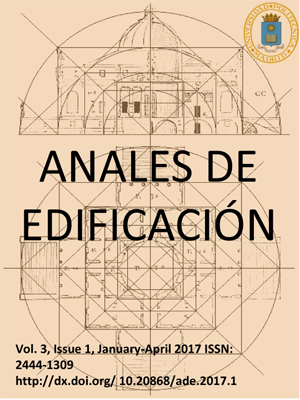Inspecciones en la gestión del agua de fachadas ventiladas basadas en la evaluación in situ y pruebas de laboratorio = Insights in the water management characteristics of rear-ventilated façades based on on-site assessment and laboratory testing
DOI:
https://doi.org/10.20868/ade.2017.3530Palabras clave:
Lluvia, fachadas ventiladas, penetración de aguas, pluviales, gestión del agua, Wind driven rain, rear-ventilated façades, rain water penetration, water managementResumen
Resumen
Las fachadas ventiladas son sistemas de construcción de fachadas contemporáneas, que incorporan funciones para la gestión del agua en su diseño y construcción. Sin embargo, muy a menudo estas funciones para la gestión de agua no funcionan adecuadamente en todo el sistema del recinto debido a un mal diseño de los detalles constructivos, fallas de construcción en la fachada o lagunas en la comprensión de los mecanismos de infiltración de lluvia, causando que el agua penetre en estos sistemas. El objetivo de este trabajo es presentar algunas ideas sobre cómo funcionan las características de gestión del agua de las fachadas ventiladas en todo el recinto del edificio. Posteriormente, se ha probado una maqueta a escala completa en condiciones de laboratorio. Finalmente, se ha realizado una comparación entre el análisis in situ y los resultados obtenidos en las pruebas de laboratorio, concluyendo que es posible mejorar el comportamiento de gestión del agua de las fachadas ventiladas con la acción combinada de la lluvia y las presiones del viento, si los mecanismos que pueden causar infiltración de agua son bien comprendidos
Abstract
Rear-ventilated façades are contemporary façade construction systems, which incorporate water management features into their design and construction. However, quite often these water management features do not properly work in the whole enclosure syste due to bad design of the constructive details, construction flaws in the façade or gaps in the understanding of the rain infiltration mechanisms causing water to penetrate in these systems. Consequently, the aim of his paper is to present some insights of how the water management features of rear-ventilated façades perform in the whole enclosure system of the building. Subsequently, a full-scale mock-up has been tested in laboratory conditions. Finally, a comparison between the on-site analysis and the results obtained in the laboratory tests has been made, concluding that it is possible to improve the water management performance of rear-ventilated façades to the combined action of wind-driven rain and driving rain wind pressures if the mechanisms that might cause water infiltration are well understood.
Descargas
Referencias
AAMA CK (2000). Rain Penetration Control Applying Current Knowledge, developed by The Canada Mortgage and Housing Corporation.
Anderson, J.M. (1988). Construction Industry Research and Information Association, Rain screen cladding: a guide to design principles and practice.
Arce, M. (2015). Proceedings of the 1st International Symposium on Building Pathology Conference, Rain infiltration mechanisms in ventilated façades: literature review, case studies, understanding common practice flaws, pp. 659.
Arce, M. (2016). Proceedings of the Central Europe towards Sustainable Building Conference, Water management in the window-wall connections of rear-ventilated façades: understanding common practice flaws, pp. 967.
Avellaneda, J. (1997). Papers de construcció ed. ETSAV, Façanes lleugeres ventilades. Criteris per al disseny constructiu.
Bassett, M.R. (1996). Drained joints – Case studies, 1996.
Birkeland, O. (1963). Norwegian Building Research Institute, Rain Penetration Investigations. A summary of the findings of CIB Working Commission on Rain Penetration, no. 36.
Chew, M.Y.L. (2001). Construction and Building Materials, A modified on‐site water chamber tester for masonry walls, no. 15, pp. 329‐337.
Chown, G.A. (1997). Construction Technology Update, Evolution of Wall Design for Controlling Rain Penetration, no. 9, December, 1997.
European Standard EN 12155 (2000). Curtain walling.
Watertightness. Laboratory test under static pressure.
European Standard EN 1027 (2000). Windows and doors.
Watertightness. Laboratory test under static pressure.
Garden, G.K. (1963). Canadian Building Digest, Rain penetration and its control, no. 40, pp. 401-404.
Huedo, P. (2010). Water penetration into ventilated façade joints.
Mas, A. (2011). Construction and Building Materials, Design and construction recommendations to improve impermeability in rainscreen walls built with natural stone coverings, no. 25, pp. 1753-1761.
Pardal, C. (2006). Ed. Bisagra, La fachada ventilada y ligera.
Rousseau, M.Z. (1998). Construction Technology Update, Pressure equalization in rainscreen wall systems, no. 17.
Sánchez, M.N. (2013). Solar Energy, Experimental assessment of the performance of open joint ventilated façades with buoyancy-driven airflow, no. 91, pp. 131-144.
Schwarz, B. (1973). HLH Bd. 24, Witterungsbeansp-bruchung von Hochhausfassaden, no. 12, pp. 376-384.
Straube, J. (1999). Journal of Thermal Envelope and Building Science, Rain control and design strategies, no. 23, pp. 41- 56.
Straube, J.F. (2001). Proceedings of the Eight Building Science and Technology Conference, Airflow control in enclosures, pp. 282-302.
Straube, J.F. (2005). Building Science Press, Building Science for Building Enclosures.
Straube, J. (2009). Building Science Press, Ventilated Wall Claddings: Review, Field Performance, and Hygrothermal Modelling”, Research Report – 0906.
Van den Bossche, N. (2013). Ph.D. Thesis, Watertightness of building components. Principles, testing and design guidelines.
Descargas
Publicado
Número
Sección
Licencia
1. Los autores conservan los derechos de autor y garantizan a la revista el derecho de una Licencia Creative Commons Atribución - Nocomercial 4.0 Internacional que permite a otros compartir el trabajo con un reconocimiento de la autoría y uso no comercial.
2. Los autores pueden establecer por separado acuerdos adicionales para la distribución no exclusiva de la versión de la obra publicada en la revista (por ejemplo, situarlo en un repositorio institucional o publicarlo en un libro).
Salvo indicación contraria, todos los contenidos de la edición electrónica se distribuyen bajo una licencia de uso y distribución “Creative Commons"












